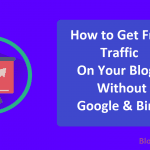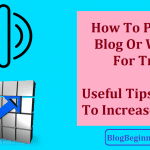Blogging can be valuable, but only if you are able to bring traffic to your blog.
So how do you do that?
Of course, the easiest way is to shell out a few bucks and get immediate traffic to your website.
As appealing as that may sound, though, it is a known fact that organic traffic converts better than paid traffic. It will not only bring traffic today, tomorrow, or next year, but probably for many years to come.
We agree that building organic traffic can be the toughest thing to do, but it isn’t impossible. With that being said, it is also the greatest investment of your time and effort.
We’ve compiled together four proven strategies that will help you increase traffic on your blog. Let’s take a look at them.
Contents In Page
1. Create Remarkable Content
The very first rule that applies here is — don’t create content just for the sake of creating it.
Here are a few guidelines that can help you create quality and SEO-optimized content for your blog.
-
Understand Your Audience
Your content should mimic the language of your readers. Do some research and find out what people are reading on Quora using your keyword. Then, write content based around it.
-
Write SEO-Optimized Articles
Always create content around your targeted keyword. Your page should be optimized around a primary keyword you have chosen.
If you have the keyword included in the post title as well, it’s easier for the search engine to find your article and rank it at the top.
-
Generate Catchy Headlines
Know that if you have a good title, the chances are 7 out of 10 people will click to read your content.
A headline should be able to catch a reader’s attention by telling a story. It should combine the objective of the article as well as the benefit that they will derive from reading it.
-
Create Evergreen Content
‘Evergreen content’ refers to creating content that is always relevant. This sort of content can generate traffic for many years after its original publication.
You can use this potential by making guide posts, list posts, how-to posts, and more. Just avoid topics like new stories, current events, and other seasonal trends.
2. Target a Long-Tail Keyword
The problem is that everyone wants to rank for those short or broad general terms because they have a high search volume.
But that’s not going to generate any traffic unless your blog is overly authoritative. Those are highly competitive keywords, and you will need to devote several months to stand a chance of ranking on the first page.
So it’s better to go for low-competition keywords that seem attainable.
For example — if you have a blog or a website that sells jackets, then don’t just try to rank for ‘jackets.’ You can optimize your page by being more specific about the product, say ‘women’s yellow jacket online.’
It also helps if you organize your content around what your audience is actually looking for. Whether they are planning to buy a jacket, or they simply want to learn about how to style the jacket, you should give them what they want.
Studies have shown that naturally optimizing for long-tail keywords increases your chances of getting organic traffic by 78%. Some of the best ways to generate long-tail keywords are by using Google Autosuggest and Google Keyword Planner.
3. Build Quality Links
It’s important to note that Google always prioritizes blogs with quality links. The more quality backlinks you have, the higher your blog is ranked.
Some of the most effective ways to get quality backlinks to your website are:
- Guest posting: This is the best and the easiest way to get quality links to your blog. Reach out to relevant websites in your niche and write content for them. You can subtly include just a few links to your site without any hint of self-promotion.
- Offer: In exchange for some good gifts or discounts on your product, you can ask influencers for a link to your blog.
- Approach influencers in your niche: Create relevant content based on your influencer’s interests such as case studies, interviews and more, and then approach them with these materials.
- Comment on relevant blogs and forums: Make a list of good blogs and forums in your related niche, and add your thoughts and comments there. Try to write something useful and relevant and include a link to your blog to let people visit your site.
Be careful not to fall into the trap of buying backlinks for the sake of improving your search engine ranking. Google recently rolled out a Penguin update, which will flag all blogs that are using spam to get links to their site.
4. Boost Your Blog on Social Media
We personally feel that social media is a great place to build curiosity so that people want to find out more about your brand.
You can get the whole world talking about you, and it indirectly impacts your site’s search engine visibility.
The more you get noticed on other platforms, the higher the chances that they will look for you online. This will send out a good signal to search engines, and they will start ranking your content first.
Make sure to add social media sharing icons on your blog so that people can easily share your content on their personal platforms.
Conclusion:
It’s pretty simple — if you want more organic traffic, you have to work for it.
Always give your best shot and look for opportunities that your rivals have missed. That way, you will eventually get new visitors to your blog and create a successful business.
If you ask us, the key is to write consistently. If you keep updating your blog on a regular basis, your users will see that you are serious about providing good content and thus, they will keep coming back.
These are all things that can help increase organic traffic. So are you ready to take your blog to the next level?








